Business Law Assignment: Contracts, Consumer Rights, and Advertising
VerifiedAdded on 2020/04/07
|11
|2709
|47
Homework Assignment
AI Summary
This business law assignment examines two key issues: contract formation and consumer rights violations. The first part analyzes whether a valid contract was formed between two parties discussing a party via email, considering offer, acceptance, and the implications of email communication in contrast to traditional postal rules. It delves into the application of the postal rule and instantaneous communication methods, citing relevant case law. The second part assesses whether a consumer, in this case, Lianne, can sue Mary for a breach of consumer rights, focusing on the Australian Consumer Law (ACL) and its provisions regarding guarantees for services. The assignment then discusses advertising law, specifically misrepresentation and false advertising, according to the ACL, and the importance of providing accurate information to consumers. The assignment provides a comprehensive overview of legal principles and their practical application in the context of business transactions and consumer protection.
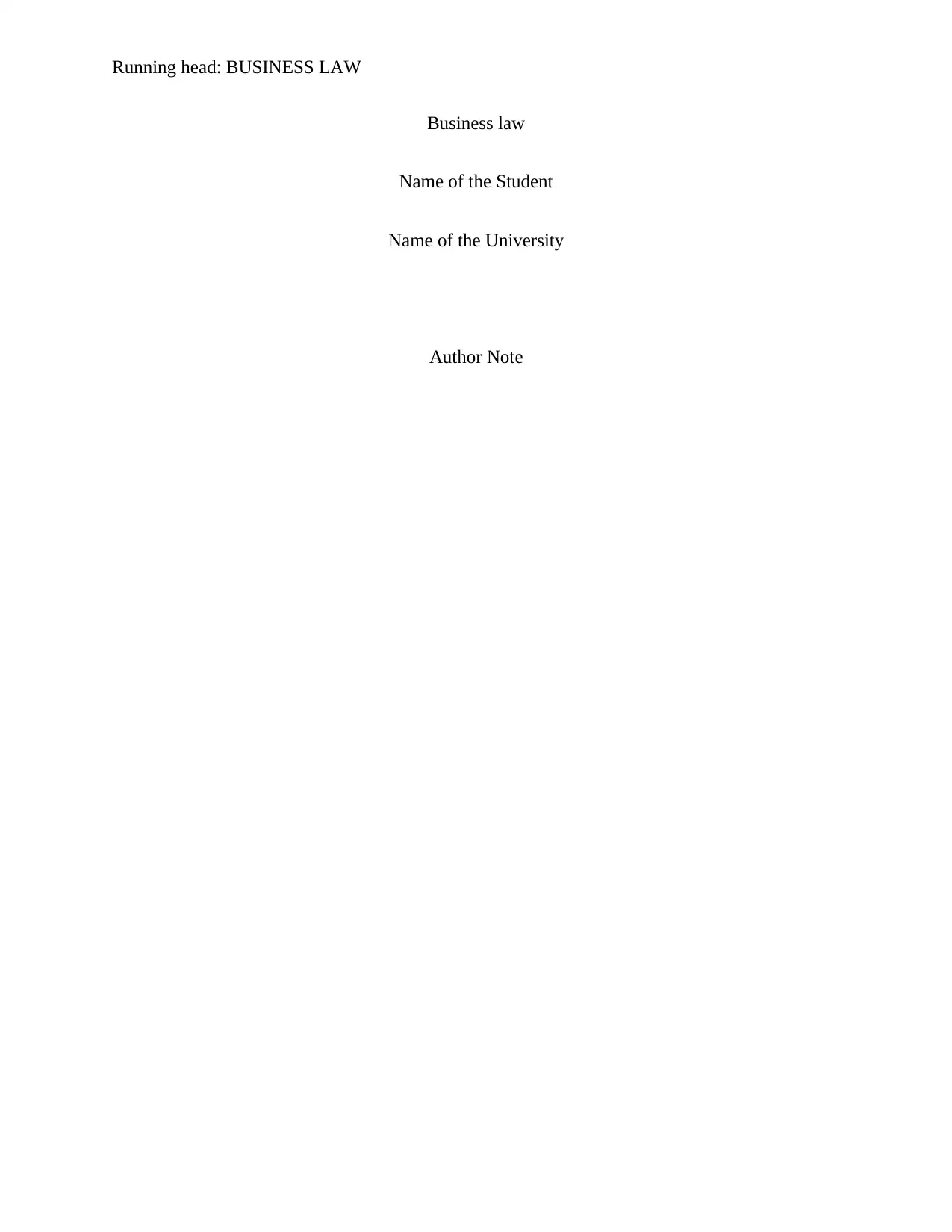
Running head: BUSINESS LAW
Business law
Name of the Student
Name of the University
Author Note
Business law
Name of the Student
Name of the University
Author Note
Paraphrase This Document
Need a fresh take? Get an instant paraphrase of this document with our AI Paraphraser
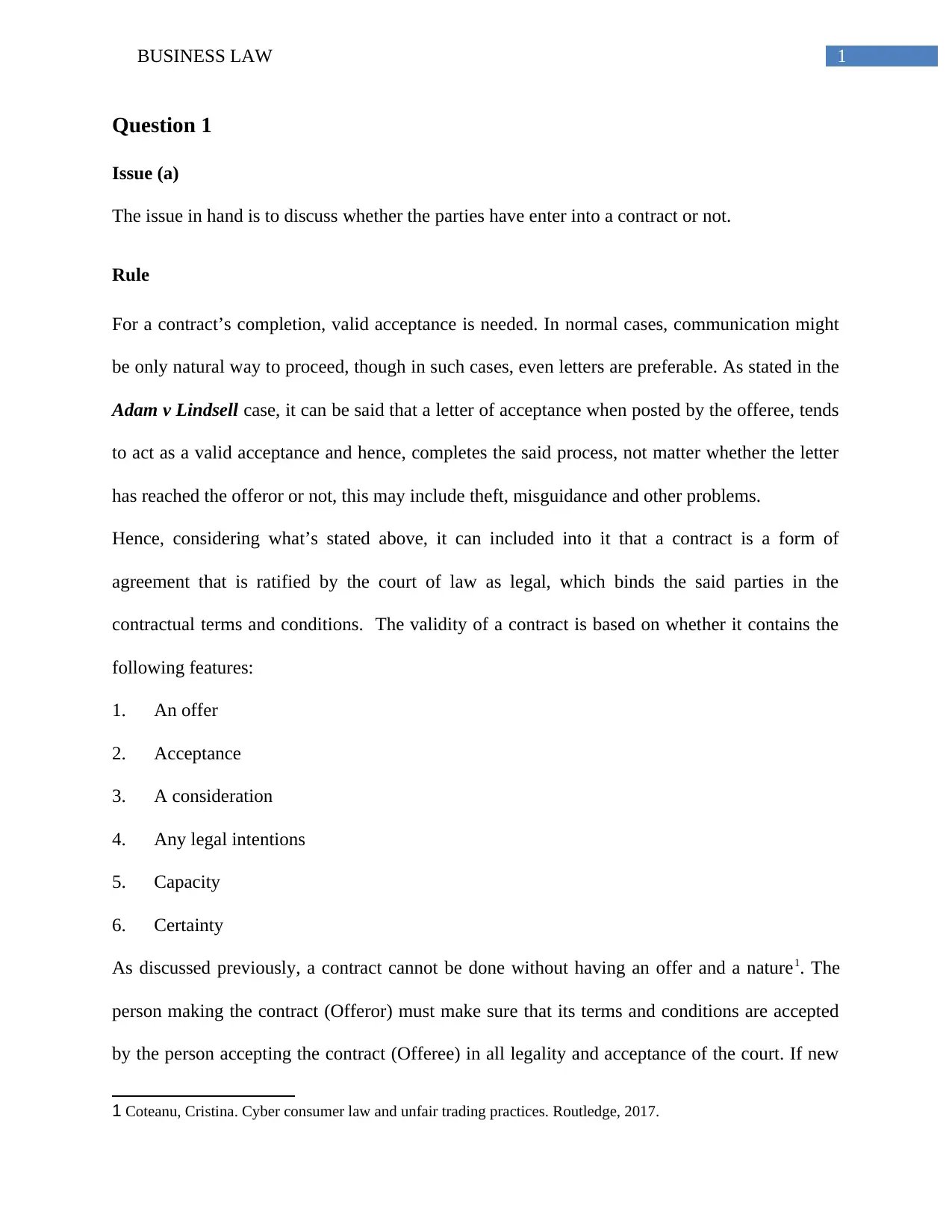
1BUSINESS LAW
Question 1
Issue (a)
The issue in hand is to discuss whether the parties have enter into a contract or not.
Rule
For a contract’s completion, valid acceptance is needed. In normal cases, communication might
be only natural way to proceed, though in such cases, even letters are preferable. As stated in the
Adam v Lindsell case, it can be said that a letter of acceptance when posted by the offeree, tends
to act as a valid acceptance and hence, completes the said process, not matter whether the letter
has reached the offeror or not, this may include theft, misguidance and other problems.
Hence, considering what’s stated above, it can included into it that a contract is a form of
agreement that is ratified by the court of law as legal, which binds the said parties in the
contractual terms and conditions. The validity of a contract is based on whether it contains the
following features:
1. An offer
2. Acceptance
3. A consideration
4. Any legal intentions
5. Capacity
6. Certainty
As discussed previously, a contract cannot be done without having an offer and a nature1. The
person making the contract (Offeror) must make sure that its terms and conditions are accepted
by the person accepting the contract (Offeree) in all legality and acceptance of the court. If new
1 Coteanu, Cristina. Cyber consumer law and unfair trading practices. Routledge, 2017.
Question 1
Issue (a)
The issue in hand is to discuss whether the parties have enter into a contract or not.
Rule
For a contract’s completion, valid acceptance is needed. In normal cases, communication might
be only natural way to proceed, though in such cases, even letters are preferable. As stated in the
Adam v Lindsell case, it can be said that a letter of acceptance when posted by the offeree, tends
to act as a valid acceptance and hence, completes the said process, not matter whether the letter
has reached the offeror or not, this may include theft, misguidance and other problems.
Hence, considering what’s stated above, it can included into it that a contract is a form of
agreement that is ratified by the court of law as legal, which binds the said parties in the
contractual terms and conditions. The validity of a contract is based on whether it contains the
following features:
1. An offer
2. Acceptance
3. A consideration
4. Any legal intentions
5. Capacity
6. Certainty
As discussed previously, a contract cannot be done without having an offer and a nature1. The
person making the contract (Offeror) must make sure that its terms and conditions are accepted
by the person accepting the contract (Offeree) in all legality and acceptance of the court. If new
1 Coteanu, Cristina. Cyber consumer law and unfair trading practices. Routledge, 2017.
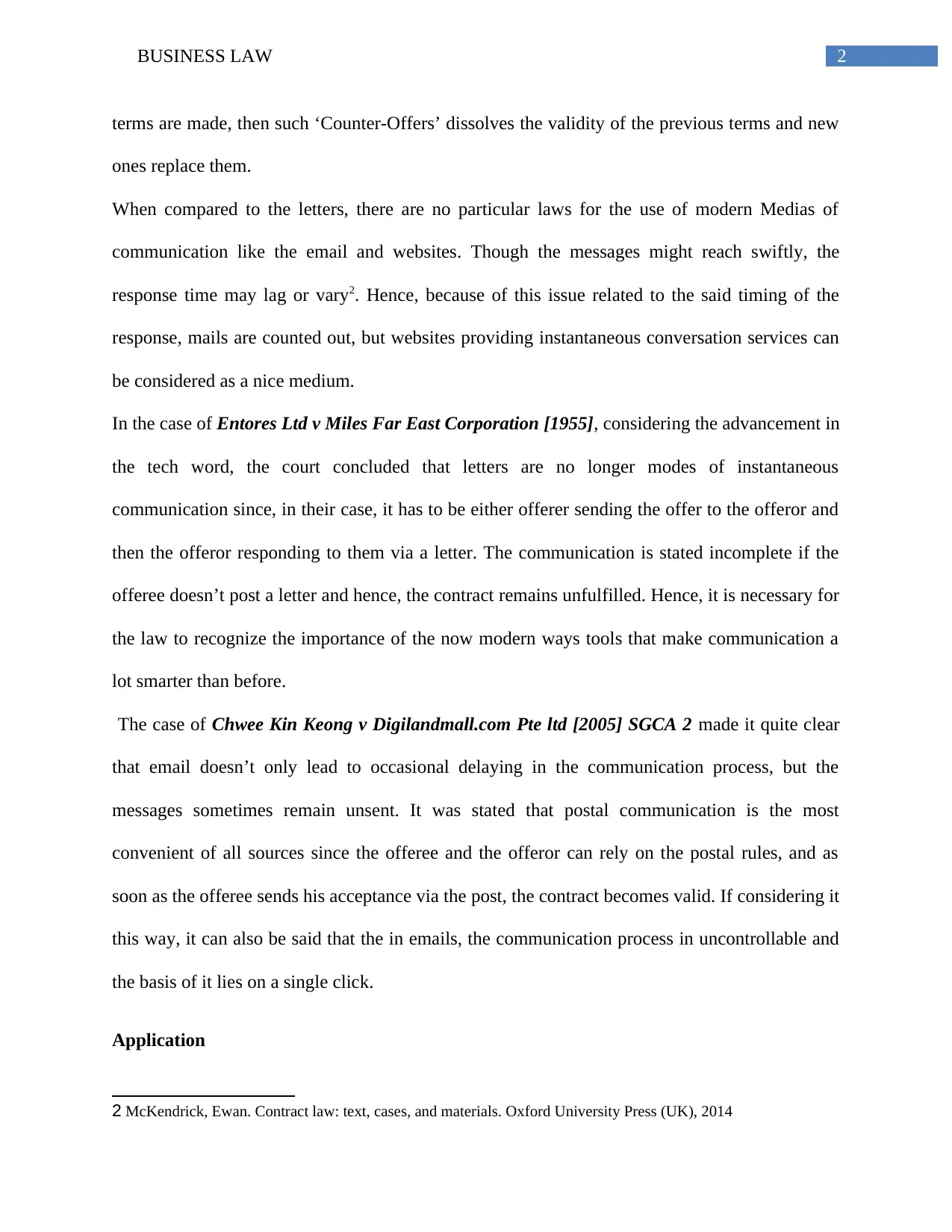
2BUSINESS LAW
terms are made, then such ‘Counter-Offers’ dissolves the validity of the previous terms and new
ones replace them.
When compared to the letters, there are no particular laws for the use of modern Medias of
communication like the email and websites. Though the messages might reach swiftly, the
response time may lag or vary2. Hence, because of this issue related to the said timing of the
response, mails are counted out, but websites providing instantaneous conversation services can
be considered as a nice medium.
In the case of Entores Ltd v Miles Far East Corporation [1955], considering the advancement in
the tech word, the court concluded that letters are no longer modes of instantaneous
communication since, in their case, it has to be either offerer sending the offer to the offeror and
then the offeror responding to them via a letter. The communication is stated incomplete if the
offeree doesn’t post a letter and hence, the contract remains unfulfilled. Hence, it is necessary for
the law to recognize the importance of the now modern ways tools that make communication a
lot smarter than before.
The case of Chwee Kin Keong v Digilandmall.com Pte ltd [2005] SGCA 2 made it quite clear
that email doesn’t only lead to occasional delaying in the communication process, but the
messages sometimes remain unsent. It was stated that postal communication is the most
convenient of all sources since the offeree and the offeror can rely on the postal rules, and as
soon as the offeree sends his acceptance via the post, the contract becomes valid. If considering it
this way, it can also be said that the in emails, the communication process in uncontrollable and
the basis of it lies on a single click.
Application
2 McKendrick, Ewan. Contract law: text, cases, and materials. Oxford University Press (UK), 2014
terms are made, then such ‘Counter-Offers’ dissolves the validity of the previous terms and new
ones replace them.
When compared to the letters, there are no particular laws for the use of modern Medias of
communication like the email and websites. Though the messages might reach swiftly, the
response time may lag or vary2. Hence, because of this issue related to the said timing of the
response, mails are counted out, but websites providing instantaneous conversation services can
be considered as a nice medium.
In the case of Entores Ltd v Miles Far East Corporation [1955], considering the advancement in
the tech word, the court concluded that letters are no longer modes of instantaneous
communication since, in their case, it has to be either offerer sending the offer to the offeror and
then the offeror responding to them via a letter. The communication is stated incomplete if the
offeree doesn’t post a letter and hence, the contract remains unfulfilled. Hence, it is necessary for
the law to recognize the importance of the now modern ways tools that make communication a
lot smarter than before.
The case of Chwee Kin Keong v Digilandmall.com Pte ltd [2005] SGCA 2 made it quite clear
that email doesn’t only lead to occasional delaying in the communication process, but the
messages sometimes remain unsent. It was stated that postal communication is the most
convenient of all sources since the offeree and the offeror can rely on the postal rules, and as
soon as the offeree sends his acceptance via the post, the contract becomes valid. If considering it
this way, it can also be said that the in emails, the communication process in uncontrollable and
the basis of it lies on a single click.
Application
2 McKendrick, Ewan. Contract law: text, cases, and materials. Oxford University Press (UK), 2014
⊘ This is a preview!⊘
Do you want full access?
Subscribe today to unlock all pages.

Trusted by 1+ million students worldwide
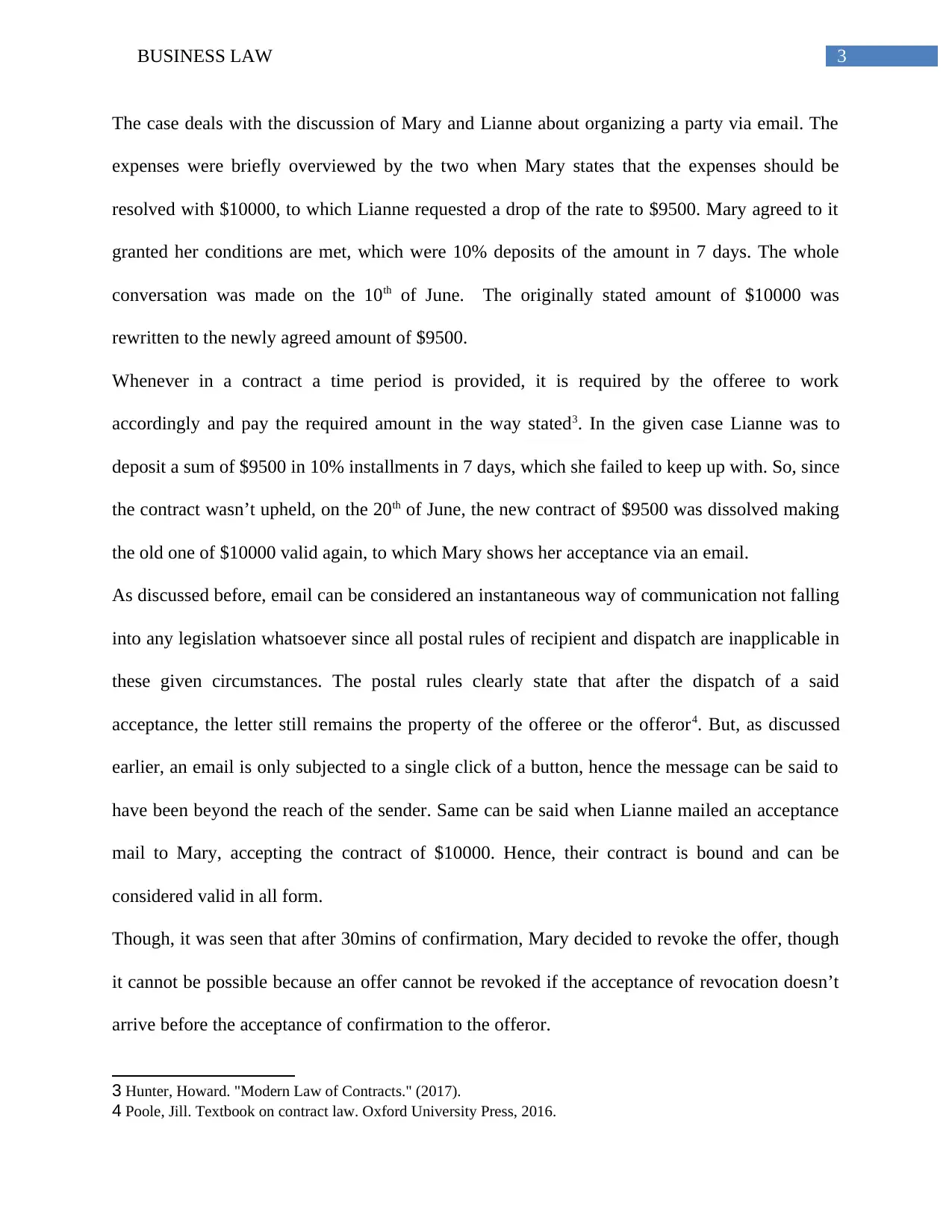
3BUSINESS LAW
The case deals with the discussion of Mary and Lianne about organizing a party via email. The
expenses were briefly overviewed by the two when Mary states that the expenses should be
resolved with $10000, to which Lianne requested a drop of the rate to $9500. Mary agreed to it
granted her conditions are met, which were 10% deposits of the amount in 7 days. The whole
conversation was made on the 10th of June. The originally stated amount of $10000 was
rewritten to the newly agreed amount of $9500.
Whenever in a contract a time period is provided, it is required by the offeree to work
accordingly and pay the required amount in the way stated3. In the given case Lianne was to
deposit a sum of $9500 in 10% installments in 7 days, which she failed to keep up with. So, since
the contract wasn’t upheld, on the 20th of June, the new contract of $9500 was dissolved making
the old one of $10000 valid again, to which Mary shows her acceptance via an email.
As discussed before, email can be considered an instantaneous way of communication not falling
into any legislation whatsoever since all postal rules of recipient and dispatch are inapplicable in
these given circumstances. The postal rules clearly state that after the dispatch of a said
acceptance, the letter still remains the property of the offeree or the offeror4. But, as discussed
earlier, an email is only subjected to a single click of a button, hence the message can be said to
have been beyond the reach of the sender. Same can be said when Lianne mailed an acceptance
mail to Mary, accepting the contract of $10000. Hence, their contract is bound and can be
considered valid in all form.
Though, it was seen that after 30mins of confirmation, Mary decided to revoke the offer, though
it cannot be possible because an offer cannot be revoked if the acceptance of revocation doesn’t
arrive before the acceptance of confirmation to the offeror.
3 Hunter, Howard. "Modern Law of Contracts." (2017).
4 Poole, Jill. Textbook on contract law. Oxford University Press, 2016.
The case deals with the discussion of Mary and Lianne about organizing a party via email. The
expenses were briefly overviewed by the two when Mary states that the expenses should be
resolved with $10000, to which Lianne requested a drop of the rate to $9500. Mary agreed to it
granted her conditions are met, which were 10% deposits of the amount in 7 days. The whole
conversation was made on the 10th of June. The originally stated amount of $10000 was
rewritten to the newly agreed amount of $9500.
Whenever in a contract a time period is provided, it is required by the offeree to work
accordingly and pay the required amount in the way stated3. In the given case Lianne was to
deposit a sum of $9500 in 10% installments in 7 days, which she failed to keep up with. So, since
the contract wasn’t upheld, on the 20th of June, the new contract of $9500 was dissolved making
the old one of $10000 valid again, to which Mary shows her acceptance via an email.
As discussed before, email can be considered an instantaneous way of communication not falling
into any legislation whatsoever since all postal rules of recipient and dispatch are inapplicable in
these given circumstances. The postal rules clearly state that after the dispatch of a said
acceptance, the letter still remains the property of the offeree or the offeror4. But, as discussed
earlier, an email is only subjected to a single click of a button, hence the message can be said to
have been beyond the reach of the sender. Same can be said when Lianne mailed an acceptance
mail to Mary, accepting the contract of $10000. Hence, their contract is bound and can be
considered valid in all form.
Though, it was seen that after 30mins of confirmation, Mary decided to revoke the offer, though
it cannot be possible because an offer cannot be revoked if the acceptance of revocation doesn’t
arrive before the acceptance of confirmation to the offeror.
3 Hunter, Howard. "Modern Law of Contracts." (2017).
4 Poole, Jill. Textbook on contract law. Oxford University Press, 2016.
Paraphrase This Document
Need a fresh take? Get an instant paraphrase of this document with our AI Paraphraser
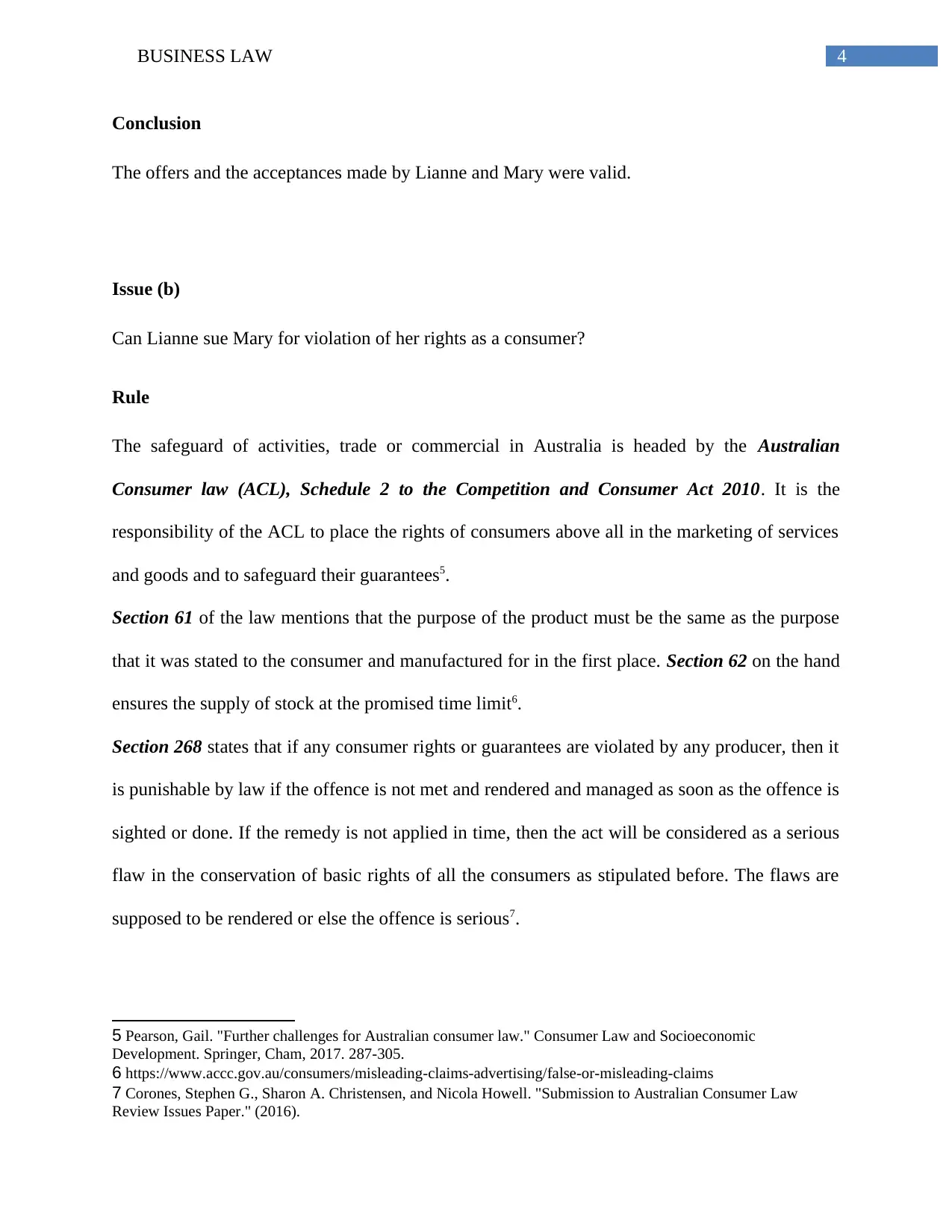
4BUSINESS LAW
Conclusion
The offers and the acceptances made by Lianne and Mary were valid.
Issue (b)
Can Lianne sue Mary for violation of her rights as a consumer?
Rule
The safeguard of activities, trade or commercial in Australia is headed by the Australian
Consumer law (ACL), Schedule 2 to the Competition and Consumer Act 2010. It is the
responsibility of the ACL to place the rights of consumers above all in the marketing of services
and goods and to safeguard their guarantees5.
Section 61 of the law mentions that the purpose of the product must be the same as the purpose
that it was stated to the consumer and manufactured for in the first place. Section 62 on the hand
ensures the supply of stock at the promised time limit6.
Section 268 states that if any consumer rights or guarantees are violated by any producer, then it
is punishable by law if the offence is not met and rendered and managed as soon as the offence is
sighted or done. If the remedy is not applied in time, then the act will be considered as a serious
flaw in the conservation of basic rights of all the consumers as stipulated before. The flaws are
supposed to be rendered or else the offence is serious7.
5 Pearson, Gail. "Further challenges for Australian consumer law." Consumer Law and Socioeconomic
Development. Springer, Cham, 2017. 287-305.
6 https://www.accc.gov.au/consumers/misleading-claims-advertising/false-or-misleading-claims
7 Corones, Stephen G., Sharon A. Christensen, and Nicola Howell. "Submission to Australian Consumer Law
Review Issues Paper." (2016).
Conclusion
The offers and the acceptances made by Lianne and Mary were valid.
Issue (b)
Can Lianne sue Mary for violation of her rights as a consumer?
Rule
The safeguard of activities, trade or commercial in Australia is headed by the Australian
Consumer law (ACL), Schedule 2 to the Competition and Consumer Act 2010. It is the
responsibility of the ACL to place the rights of consumers above all in the marketing of services
and goods and to safeguard their guarantees5.
Section 61 of the law mentions that the purpose of the product must be the same as the purpose
that it was stated to the consumer and manufactured for in the first place. Section 62 on the hand
ensures the supply of stock at the promised time limit6.
Section 268 states that if any consumer rights or guarantees are violated by any producer, then it
is punishable by law if the offence is not met and rendered and managed as soon as the offence is
sighted or done. If the remedy is not applied in time, then the act will be considered as a serious
flaw in the conservation of basic rights of all the consumers as stipulated before. The flaws are
supposed to be rendered or else the offence is serious7.
5 Pearson, Gail. "Further challenges for Australian consumer law." Consumer Law and Socioeconomic
Development. Springer, Cham, 2017. 287-305.
6 https://www.accc.gov.au/consumers/misleading-claims-advertising/false-or-misleading-claims
7 Corones, Stephen G., Sharon A. Christensen, and Nicola Howell. "Submission to Australian Consumer Law
Review Issues Paper." (2016).
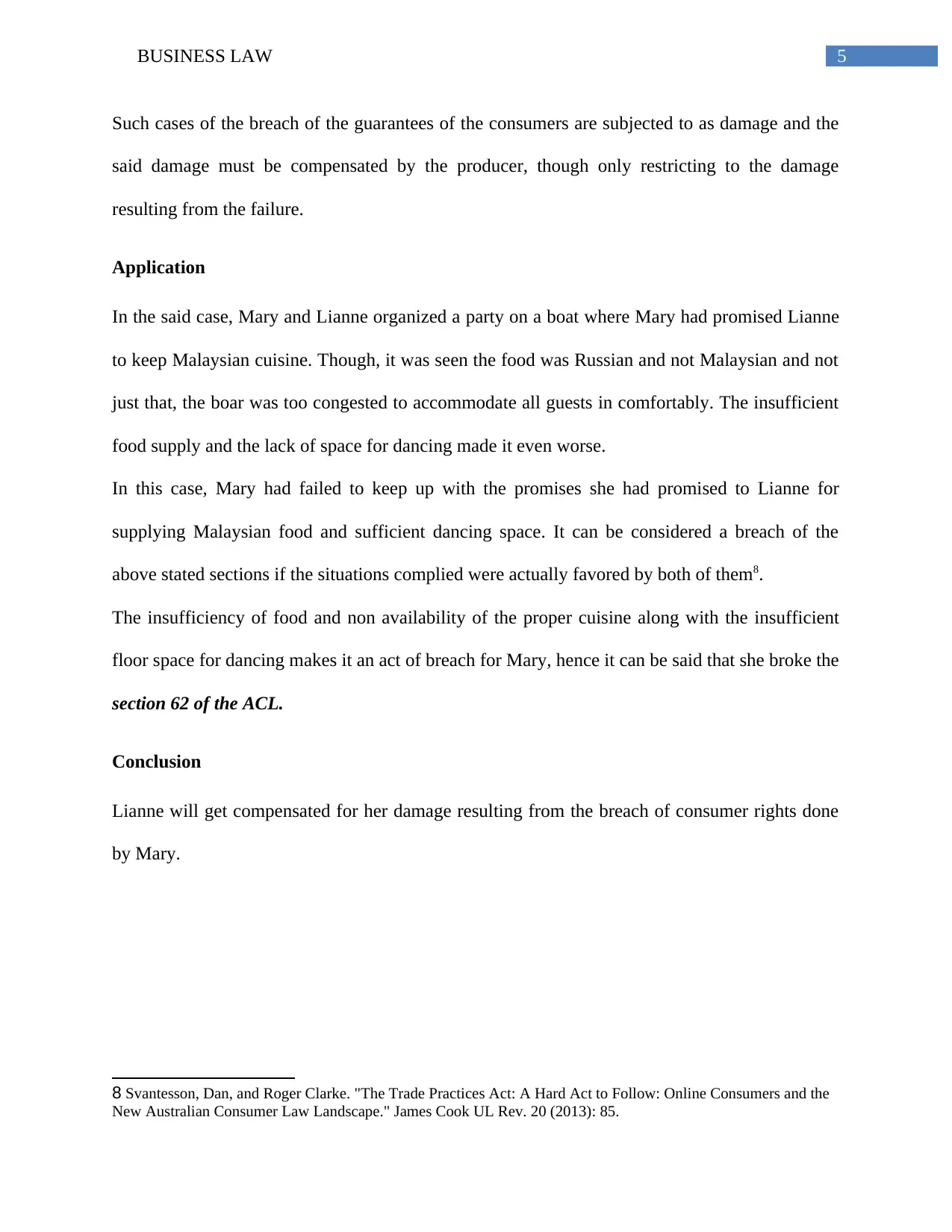
5BUSINESS LAW
Such cases of the breach of the guarantees of the consumers are subjected to as damage and the
said damage must be compensated by the producer, though only restricting to the damage
resulting from the failure.
Application
In the said case, Mary and Lianne organized a party on a boat where Mary had promised Lianne
to keep Malaysian cuisine. Though, it was seen the food was Russian and not Malaysian and not
just that, the boar was too congested to accommodate all guests in comfortably. The insufficient
food supply and the lack of space for dancing made it even worse.
In this case, Mary had failed to keep up with the promises she had promised to Lianne for
supplying Malaysian food and sufficient dancing space. It can be considered a breach of the
above stated sections if the situations complied were actually favored by both of them8.
The insufficiency of food and non availability of the proper cuisine along with the insufficient
floor space for dancing makes it an act of breach for Mary, hence it can be said that she broke the
section 62 of the ACL.
Conclusion
Lianne will get compensated for her damage resulting from the breach of consumer rights done
by Mary.
8 Svantesson, Dan, and Roger Clarke. "The Trade Practices Act: A Hard Act to Follow: Online Consumers and the
New Australian Consumer Law Landscape." James Cook UL Rev. 20 (2013): 85.
Such cases of the breach of the guarantees of the consumers are subjected to as damage and the
said damage must be compensated by the producer, though only restricting to the damage
resulting from the failure.
Application
In the said case, Mary and Lianne organized a party on a boat where Mary had promised Lianne
to keep Malaysian cuisine. Though, it was seen the food was Russian and not Malaysian and not
just that, the boar was too congested to accommodate all guests in comfortably. The insufficient
food supply and the lack of space for dancing made it even worse.
In this case, Mary had failed to keep up with the promises she had promised to Lianne for
supplying Malaysian food and sufficient dancing space. It can be considered a breach of the
above stated sections if the situations complied were actually favored by both of them8.
The insufficiency of food and non availability of the proper cuisine along with the insufficient
floor space for dancing makes it an act of breach for Mary, hence it can be said that she broke the
section 62 of the ACL.
Conclusion
Lianne will get compensated for her damage resulting from the breach of consumer rights done
by Mary.
8 Svantesson, Dan, and Roger Clarke. "The Trade Practices Act: A Hard Act to Follow: Online Consumers and the
New Australian Consumer Law Landscape." James Cook UL Rev. 20 (2013): 85.
⊘ This is a preview!⊘
Do you want full access?
Subscribe today to unlock all pages.

Trusted by 1+ million students worldwide
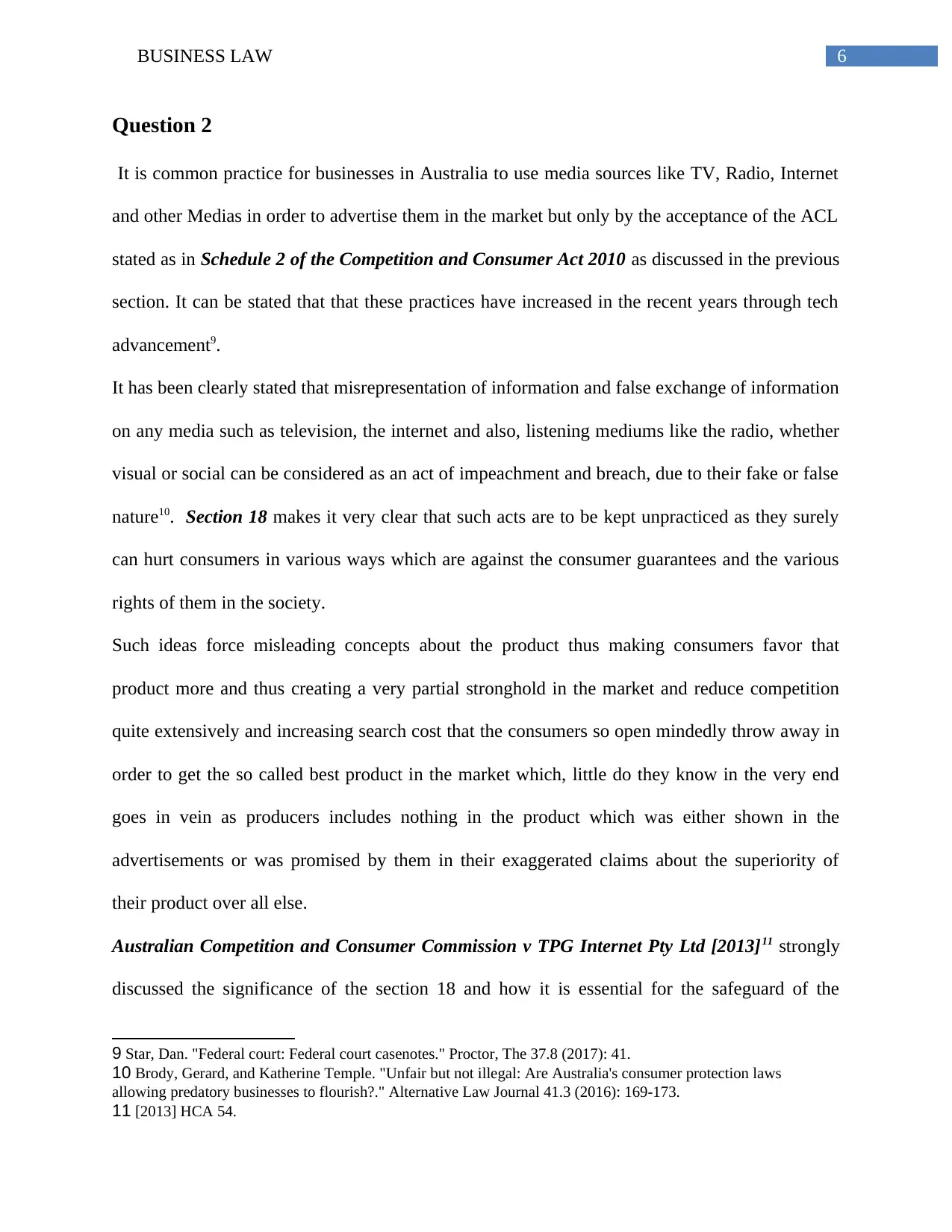
6BUSINESS LAW
Question 2
It is common practice for businesses in Australia to use media sources like TV, Radio, Internet
and other Medias in order to advertise them in the market but only by the acceptance of the ACL
stated as in Schedule 2 of the Competition and Consumer Act 2010 as discussed in the previous
section. It can be stated that that these practices have increased in the recent years through tech
advancement9.
It has been clearly stated that misrepresentation of information and false exchange of information
on any media such as television, the internet and also, listening mediums like the radio, whether
visual or social can be considered as an act of impeachment and breach, due to their fake or false
nature10. Section 18 makes it very clear that such acts are to be kept unpracticed as they surely
can hurt consumers in various ways which are against the consumer guarantees and the various
rights of them in the society.
Such ideas force misleading concepts about the product thus making consumers favor that
product more and thus creating a very partial stronghold in the market and reduce competition
quite extensively and increasing search cost that the consumers so open mindedly throw away in
order to get the so called best product in the market which, little do they know in the very end
goes in vein as producers includes nothing in the product which was either shown in the
advertisements or was promised by them in their exaggerated claims about the superiority of
their product over all else.
Australian Competition and Consumer Commission v TPG Internet Pty Ltd [2013]11 strongly
discussed the significance of the section 18 and how it is essential for the safeguard of the
9 Star, Dan. "Federal court: Federal court casenotes." Proctor, The 37.8 (2017): 41.
10 Brody, Gerard, and Katherine Temple. "Unfair but not illegal: Are Australia's consumer protection laws
allowing predatory businesses to flourish?." Alternative Law Journal 41.3 (2016): 169-173.
11 [2013] HCA 54.
Question 2
It is common practice for businesses in Australia to use media sources like TV, Radio, Internet
and other Medias in order to advertise them in the market but only by the acceptance of the ACL
stated as in Schedule 2 of the Competition and Consumer Act 2010 as discussed in the previous
section. It can be stated that that these practices have increased in the recent years through tech
advancement9.
It has been clearly stated that misrepresentation of information and false exchange of information
on any media such as television, the internet and also, listening mediums like the radio, whether
visual or social can be considered as an act of impeachment and breach, due to their fake or false
nature10. Section 18 makes it very clear that such acts are to be kept unpracticed as they surely
can hurt consumers in various ways which are against the consumer guarantees and the various
rights of them in the society.
Such ideas force misleading concepts about the product thus making consumers favor that
product more and thus creating a very partial stronghold in the market and reduce competition
quite extensively and increasing search cost that the consumers so open mindedly throw away in
order to get the so called best product in the market which, little do they know in the very end
goes in vein as producers includes nothing in the product which was either shown in the
advertisements or was promised by them in their exaggerated claims about the superiority of
their product over all else.
Australian Competition and Consumer Commission v TPG Internet Pty Ltd [2013]11 strongly
discussed the significance of the section 18 and how it is essential for the safeguard of the
9 Star, Dan. "Federal court: Federal court casenotes." Proctor, The 37.8 (2017): 41.
10 Brody, Gerard, and Katherine Temple. "Unfair but not illegal: Are Australia's consumer protection laws
allowing predatory businesses to flourish?." Alternative Law Journal 41.3 (2016): 169-173.
11 [2013] HCA 54.
Paraphrase This Document
Need a fresh take? Get an instant paraphrase of this document with our AI Paraphraser
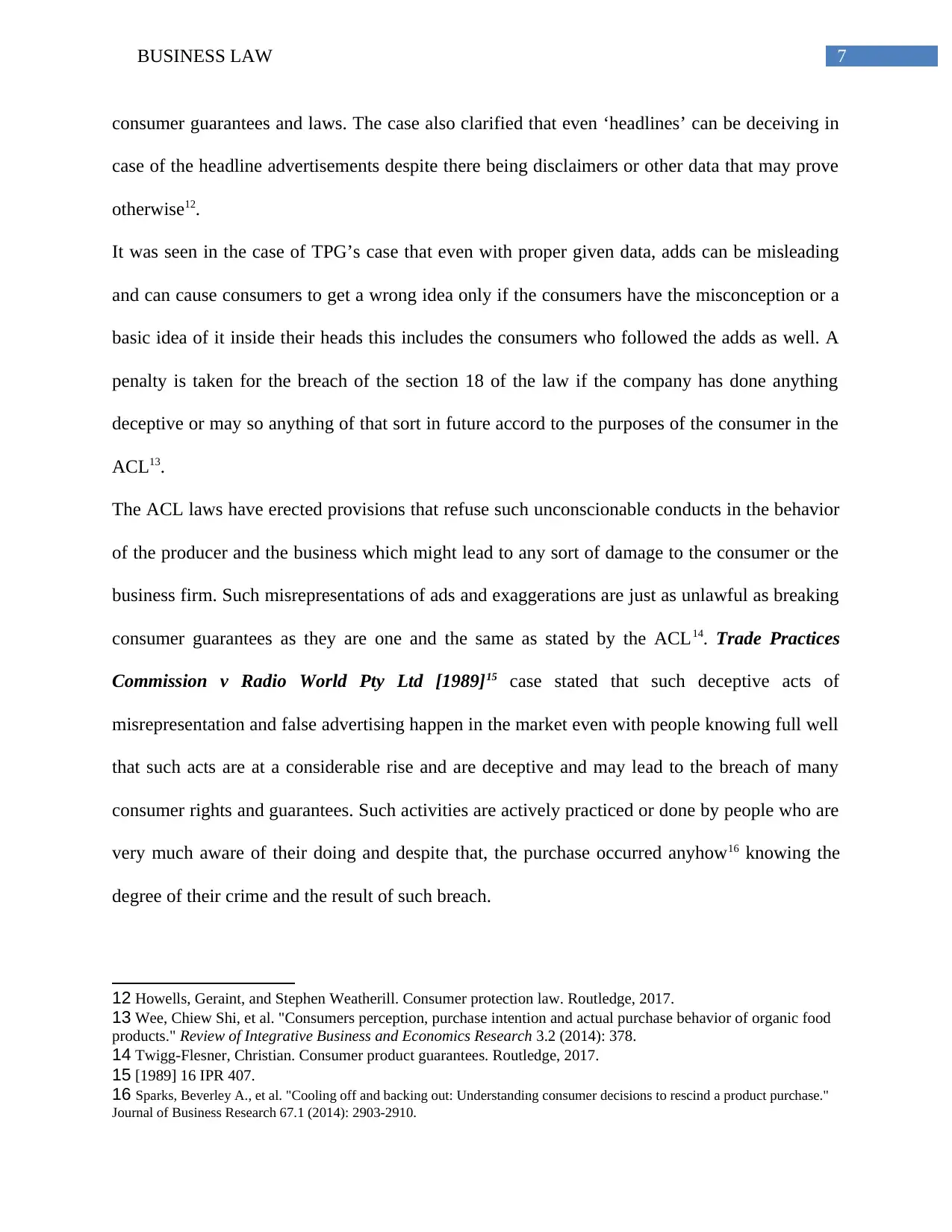
7BUSINESS LAW
consumer guarantees and laws. The case also clarified that even ‘headlines’ can be deceiving in
case of the headline advertisements despite there being disclaimers or other data that may prove
otherwise12.
It was seen in the case of TPG’s case that even with proper given data, adds can be misleading
and can cause consumers to get a wrong idea only if the consumers have the misconception or a
basic idea of it inside their heads this includes the consumers who followed the adds as well. A
penalty is taken for the breach of the section 18 of the law if the company has done anything
deceptive or may so anything of that sort in future accord to the purposes of the consumer in the
ACL13.
The ACL laws have erected provisions that refuse such unconscionable conducts in the behavior
of the producer and the business which might lead to any sort of damage to the consumer or the
business firm. Such misrepresentations of ads and exaggerations are just as unlawful as breaking
consumer guarantees as they are one and the same as stated by the ACL14. Trade Practices
Commission v Radio World Pty Ltd [1989]15 case stated that such deceptive acts of
misrepresentation and false advertising happen in the market even with people knowing full well
that such acts are at a considerable rise and are deceptive and may lead to the breach of many
consumer rights and guarantees. Such activities are actively practiced or done by people who are
very much aware of their doing and despite that, the purchase occurred anyhow16 knowing the
degree of their crime and the result of such breach.
12 Howells, Geraint, and Stephen Weatherill. Consumer protection law. Routledge, 2017.
13 Wee, Chiew Shi, et al. "Consumers perception, purchase intention and actual purchase behavior of organic food
products." Review of Integrative Business and Economics Research 3.2 (2014): 378.
14 Twigg-Flesner, Christian. Consumer product guarantees. Routledge, 2017.
15 [1989] 16 IPR 407.
16 Sparks, Beverley A., et al. "Cooling off and backing out: Understanding consumer decisions to rescind a product purchase."
Journal of Business Research 67.1 (2014): 2903-2910.
consumer guarantees and laws. The case also clarified that even ‘headlines’ can be deceiving in
case of the headline advertisements despite there being disclaimers or other data that may prove
otherwise12.
It was seen in the case of TPG’s case that even with proper given data, adds can be misleading
and can cause consumers to get a wrong idea only if the consumers have the misconception or a
basic idea of it inside their heads this includes the consumers who followed the adds as well. A
penalty is taken for the breach of the section 18 of the law if the company has done anything
deceptive or may so anything of that sort in future accord to the purposes of the consumer in the
ACL13.
The ACL laws have erected provisions that refuse such unconscionable conducts in the behavior
of the producer and the business which might lead to any sort of damage to the consumer or the
business firm. Such misrepresentations of ads and exaggerations are just as unlawful as breaking
consumer guarantees as they are one and the same as stated by the ACL14. Trade Practices
Commission v Radio World Pty Ltd [1989]15 case stated that such deceptive acts of
misrepresentation and false advertising happen in the market even with people knowing full well
that such acts are at a considerable rise and are deceptive and may lead to the breach of many
consumer rights and guarantees. Such activities are actively practiced or done by people who are
very much aware of their doing and despite that, the purchase occurred anyhow16 knowing the
degree of their crime and the result of such breach.
12 Howells, Geraint, and Stephen Weatherill. Consumer protection law. Routledge, 2017.
13 Wee, Chiew Shi, et al. "Consumers perception, purchase intention and actual purchase behavior of organic food
products." Review of Integrative Business and Economics Research 3.2 (2014): 378.
14 Twigg-Flesner, Christian. Consumer product guarantees. Routledge, 2017.
15 [1989] 16 IPR 407.
16 Sparks, Beverley A., et al. "Cooling off and backing out: Understanding consumer decisions to rescind a product purchase."
Journal of Business Research 67.1 (2014): 2903-2910.
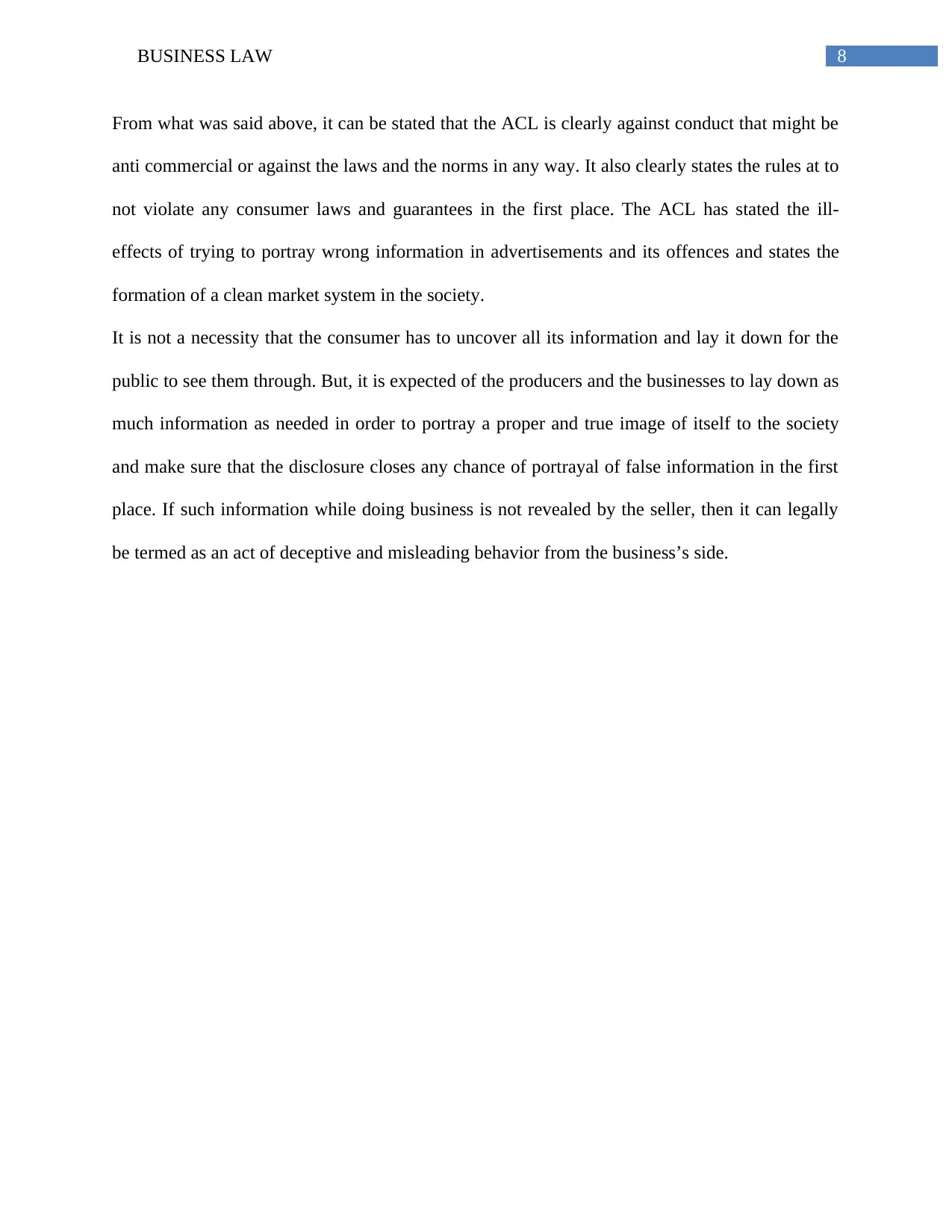
8BUSINESS LAW
From what was said above, it can be stated that the ACL is clearly against conduct that might be
anti commercial or against the laws and the norms in any way. It also clearly states the rules at to
not violate any consumer laws and guarantees in the first place. The ACL has stated the ill-
effects of trying to portray wrong information in advertisements and its offences and states the
formation of a clean market system in the society.
It is not a necessity that the consumer has to uncover all its information and lay it down for the
public to see them through. But, it is expected of the producers and the businesses to lay down as
much information as needed in order to portray a proper and true image of itself to the society
and make sure that the disclosure closes any chance of portrayal of false information in the first
place. If such information while doing business is not revealed by the seller, then it can legally
be termed as an act of deceptive and misleading behavior from the business’s side.
From what was said above, it can be stated that the ACL is clearly against conduct that might be
anti commercial or against the laws and the norms in any way. It also clearly states the rules at to
not violate any consumer laws and guarantees in the first place. The ACL has stated the ill-
effects of trying to portray wrong information in advertisements and its offences and states the
formation of a clean market system in the society.
It is not a necessity that the consumer has to uncover all its information and lay it down for the
public to see them through. But, it is expected of the producers and the businesses to lay down as
much information as needed in order to portray a proper and true image of itself to the society
and make sure that the disclosure closes any chance of portrayal of false information in the first
place. If such information while doing business is not revealed by the seller, then it can legally
be termed as an act of deceptive and misleading behavior from the business’s side.
⊘ This is a preview!⊘
Do you want full access?
Subscribe today to unlock all pages.

Trusted by 1+ million students worldwide
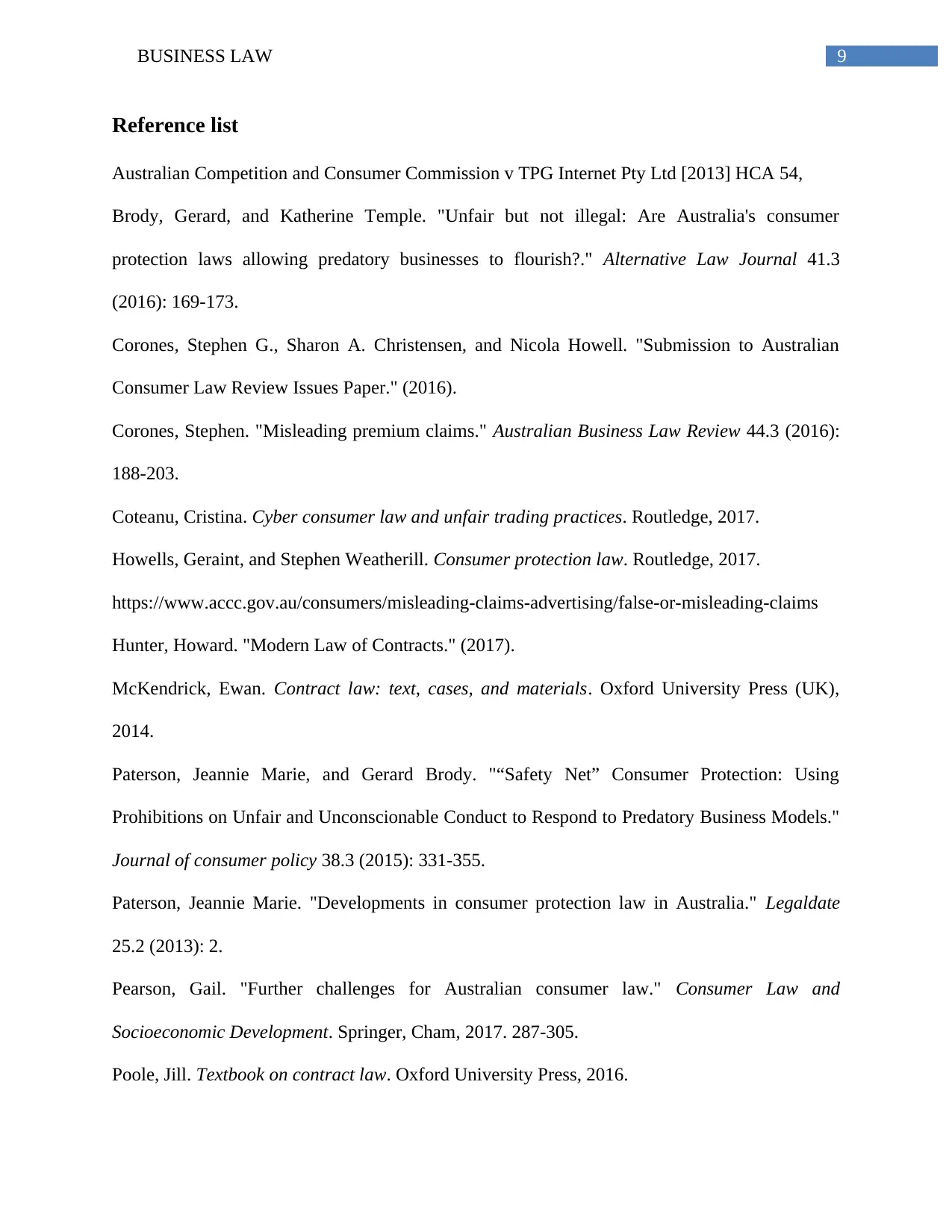
9BUSINESS LAW
Reference list
Australian Competition and Consumer Commission v TPG Internet Pty Ltd [2013] HCA 54,
Brody, Gerard, and Katherine Temple. "Unfair but not illegal: Are Australia's consumer
protection laws allowing predatory businesses to flourish?." Alternative Law Journal 41.3
(2016): 169-173.
Corones, Stephen G., Sharon A. Christensen, and Nicola Howell. "Submission to Australian
Consumer Law Review Issues Paper." (2016).
Corones, Stephen. "Misleading premium claims." Australian Business Law Review 44.3 (2016):
188-203.
Coteanu, Cristina. Cyber consumer law and unfair trading practices. Routledge, 2017.
Howells, Geraint, and Stephen Weatherill. Consumer protection law. Routledge, 2017.
https://www.accc.gov.au/consumers/misleading-claims-advertising/false-or-misleading-claims
Hunter, Howard. "Modern Law of Contracts." (2017).
McKendrick, Ewan. Contract law: text, cases, and materials. Oxford University Press (UK),
2014.
Paterson, Jeannie Marie, and Gerard Brody. "“Safety Net” Consumer Protection: Using
Prohibitions on Unfair and Unconscionable Conduct to Respond to Predatory Business Models."
Journal of consumer policy 38.3 (2015): 331-355.
Paterson, Jeannie Marie. "Developments in consumer protection law in Australia." Legaldate
25.2 (2013): 2.
Pearson, Gail. "Further challenges for Australian consumer law." Consumer Law and
Socioeconomic Development. Springer, Cham, 2017. 287-305.
Poole, Jill. Textbook on contract law. Oxford University Press, 2016.
Reference list
Australian Competition and Consumer Commission v TPG Internet Pty Ltd [2013] HCA 54,
Brody, Gerard, and Katherine Temple. "Unfair but not illegal: Are Australia's consumer
protection laws allowing predatory businesses to flourish?." Alternative Law Journal 41.3
(2016): 169-173.
Corones, Stephen G., Sharon A. Christensen, and Nicola Howell. "Submission to Australian
Consumer Law Review Issues Paper." (2016).
Corones, Stephen. "Misleading premium claims." Australian Business Law Review 44.3 (2016):
188-203.
Coteanu, Cristina. Cyber consumer law and unfair trading practices. Routledge, 2017.
Howells, Geraint, and Stephen Weatherill. Consumer protection law. Routledge, 2017.
https://www.accc.gov.au/consumers/misleading-claims-advertising/false-or-misleading-claims
Hunter, Howard. "Modern Law of Contracts." (2017).
McKendrick, Ewan. Contract law: text, cases, and materials. Oxford University Press (UK),
2014.
Paterson, Jeannie Marie, and Gerard Brody. "“Safety Net” Consumer Protection: Using
Prohibitions on Unfair and Unconscionable Conduct to Respond to Predatory Business Models."
Journal of consumer policy 38.3 (2015): 331-355.
Paterson, Jeannie Marie. "Developments in consumer protection law in Australia." Legaldate
25.2 (2013): 2.
Pearson, Gail. "Further challenges for Australian consumer law." Consumer Law and
Socioeconomic Development. Springer, Cham, 2017. 287-305.
Poole, Jill. Textbook on contract law. Oxford University Press, 2016.
Paraphrase This Document
Need a fresh take? Get an instant paraphrase of this document with our AI Paraphraser
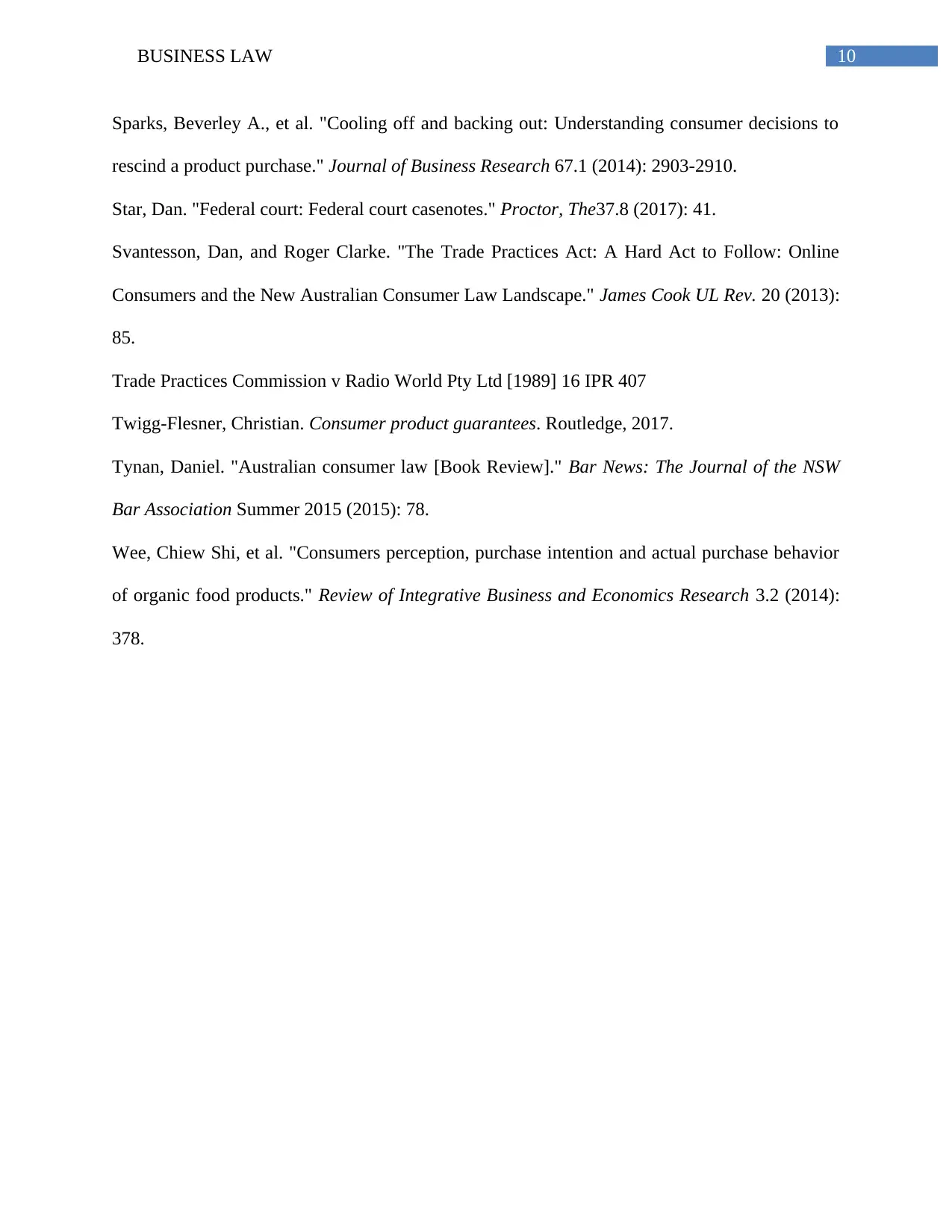
10BUSINESS LAW
Sparks, Beverley A., et al. "Cooling off and backing out: Understanding consumer decisions to
rescind a product purchase." Journal of Business Research 67.1 (2014): 2903-2910.
Star, Dan. "Federal court: Federal court casenotes." Proctor, The37.8 (2017): 41.
Svantesson, Dan, and Roger Clarke. "The Trade Practices Act: A Hard Act to Follow: Online
Consumers and the New Australian Consumer Law Landscape." James Cook UL Rev. 20 (2013):
85.
Trade Practices Commission v Radio World Pty Ltd [1989] 16 IPR 407
Twigg-Flesner, Christian. Consumer product guarantees. Routledge, 2017.
Tynan, Daniel. "Australian consumer law [Book Review]." Bar News: The Journal of the NSW
Bar Association Summer 2015 (2015): 78.
Wee, Chiew Shi, et al. "Consumers perception, purchase intention and actual purchase behavior
of organic food products." Review of Integrative Business and Economics Research 3.2 (2014):
378.
Sparks, Beverley A., et al. "Cooling off and backing out: Understanding consumer decisions to
rescind a product purchase." Journal of Business Research 67.1 (2014): 2903-2910.
Star, Dan. "Federal court: Federal court casenotes." Proctor, The37.8 (2017): 41.
Svantesson, Dan, and Roger Clarke. "The Trade Practices Act: A Hard Act to Follow: Online
Consumers and the New Australian Consumer Law Landscape." James Cook UL Rev. 20 (2013):
85.
Trade Practices Commission v Radio World Pty Ltd [1989] 16 IPR 407
Twigg-Flesner, Christian. Consumer product guarantees. Routledge, 2017.
Tynan, Daniel. "Australian consumer law [Book Review]." Bar News: The Journal of the NSW
Bar Association Summer 2015 (2015): 78.
Wee, Chiew Shi, et al. "Consumers perception, purchase intention and actual purchase behavior
of organic food products." Review of Integrative Business and Economics Research 3.2 (2014):
378.
1 out of 11
Related Documents
Your All-in-One AI-Powered Toolkit for Academic Success.
+13062052269
info@desklib.com
Available 24*7 on WhatsApp / Email
![[object Object]](/_next/static/media/star-bottom.7253800d.svg)
Unlock your academic potential
Copyright © 2020–2025 A2Z Services. All Rights Reserved. Developed and managed by ZUCOL.





